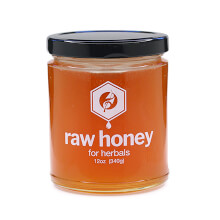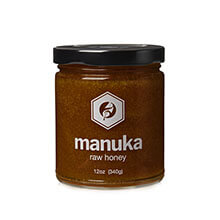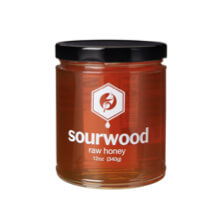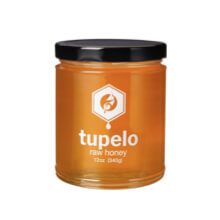Deep Dive on Raw Honey Crystallization
October 26, 2023

The Science of Honey Crystallization and Its Color Metamorphosis
Honey is more than just a natural sweetener; it's a complex and versatile substance with a rich history spanning thousands of years. One intriguing aspect of honey is its tendency to crystallize over time, transforming from its familiar liquid form into a grainy, semi-solid state.Along with this metamorphosis in texture, honey can also change colors, leaving many curious about the science behind these transformations. In this article, we will explore the fascinating process of honey crystallization and its connection to color changes.

Understanding Honey Crystallization
Honey crystallization, also known as granulation, is a natural occurrence that happens to most types of honey. It is a reversible process, and crystallized honey can return to its liquid state with gentle heating. The primary reason behind honey crystallization is its composition.Honey consists mainly of sugars, primarily glucose and fructose. The ratio of these sugars, along with other factors, determines how quickly or slowly honey crystallizes.
Sugar Content
Honey with a higher glucose content tends to crystallize faster than honey with more fructose. Glucose molecules are more likely to come together to form crystals, while fructose remains in a liquid state.
Water Content
The water content of honey plays a significant role in crystallization. Honey with lower water content is more prone to crystallize because there is less moisture available to keep the sugars in a liquid state.
Temperature
Temperature is another key factor. Honey crystallizes faster at cooler temperatures. If honey is stored in a cold environment, it is more likely to crystallize.
Impurities and Particles
Tiny particles like pollen, wax, or even leftover crystals from a previous crystallization can serve as nuclei for crystallization. These particles provide a surface for sugar molecules to attach to, kickstarting the crystallization process.
The Crystallization Process
The crystallization process begins when glucose molecules form solid crystals. These crystals serve as a framework for other sugar molecules to attach to, gradually forming a network of sugar crystals throughout the honey. The result is a thicker, grainy texture.Honey doesn't crystallize uniformly. The process can vary depending on the honey's composition and storage conditions. Some honeys crystallize quickly and evenly, while others may have a more irregular texture.

Why Does Honey Change Colors?
The color of honey is primarily determined by the nectar source visited by bees. It can range from pale gold to deep amber, and even dark brown. The coloration is influenced by the types of flowers the bees collect nectar from and the presence of other substances like pollen and propolis.When honey crystallizes, its color can change, and there are a few reasons for this phenomenon:
Light Scattering
As honey crystallizes, the sugar crystals scatter light differently than liquid honey. This can make the honey appear lighter or darker, depending on the crystal size and distribution.
Air Bubbles
Crystallized honey often contains tiny air bubbles trapped within the crystal matrix. These bubbles can reflect and refract light, affecting the honey's appearance.
Presence of Impurities
The presence of pollen, propolis, or other substances in honey can influence its color, especially when these particles are concentrated in certain areas within the crystallized honey.
Age
Over time, honey can naturally darken due to the Maillard reaction, a complex chemical process that occurs when sugars and amino acids interact. This reaction is more likely to occur in heated or aged honey.
It's essential to note that while crystallization and color change are natural processes, they do not affect honey's safety or taste. In fact, many people prefer crystallized honey for its spreadable consistency and milder flavor.

Preventing and Reversing Crystallization
If you prefer liquid honey or need to use honey in a recipe that requires it to be in liquid form, you can easily reverse crystallization. Here's how:Warm Water Bath
Place the crystallized honey container in a warm water bath, and let it sit until the crystals dissolve. Be cautious not to overheat the honey, as excessive heat can damage its flavor and nutritional properties.
Microwave
If you're in a hurry, you can use a microwave to gently warm the crystallized honey. Use short bursts of low heat and stir in between to avoid overheating.
To prevent crystallization, store honey in a dry, cool place at temperatures between 50°F to 70°F (10°C to 21°C). Avoid exposing it to excessive heat or moisture. Additionally, choose honey with a higher fructose content, as it tends to crystallize more slowly.

Crystallization and Winter
Crystallization is more likely to occur in the winter months due to the lower temperatures typically experienced during this season.Honey has a natural tendency to crystallize when the temperature drops. Cold temperatures encourage the glucose molecules in honey to come together and form solid crystals. This process is further accelerated if the honey is stored in a cold environment, such as a chilly pantry or kitchen cabinet. While honey may remain in its liquid form at warmer temperatures, the onset of winter often prompts the crystallization process, leading to the formation of those fine sugar crystals that give honey its characteristic grainy texture.
However, it's important to emphasize that crystallization does not harm the quality or taste of honey, and it can be easily reversed with gentle heating, as mentioned earlier.